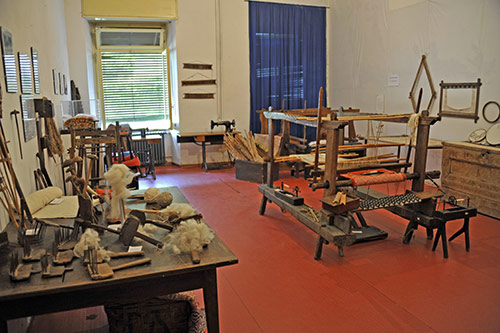Aritzo
map of Aritzo with the marked sights

Aritzo is beautifully situated on a mountainside. Regardless of which direction you come from, the journey here is long and winding.
Surrounding the area are extensive chestnut and hazelnut forests, inviting for hikes and walks. One of the most popular destinations is the tabletop mountain Monte Texile. From there, you have a stunning view of the village and the surrounding mountains.
Many Sardinians come to Aritzo during the summer months to escape the hot temperatures of the coastal areas. This tradition dates back to the 19th century, as people were safe from the dreaded malaria up here. At that time, Aritzo had more hotels than Cagliari.
A good starting point is the Ufficio Turistico on the main road (see map). Here, you can get a lot of useful information and also an overview map with all the important facilities.
The Ethnographic Museum
 Also known as the “Ecomuseo della montagna sarda o del Gennargentu,” it houses an extensive collection of traditional exhibits.
Also known as the “Ecomuseo della montagna sarda o del Gennargentu,” it houses an extensive collection of traditional exhibits.
Approximately 3,500 exhibits provide an overview of various Sardinian crafts, the life of shepherds, and the processing of agricultural products.
In the surrounding forests, chestnuts (maroni) and hazelnuts have always been collected. Every year, at the end of October, a huge multi-day festival is dedicated to chestnuts and hazelnuts – the Sagra delle Castagne e delle Nocciole. During this time, tens of thousands of visitors flock to the village of 1300 inhabitants. There are traditional processions, Sardinian specialties, and of course, chestnuts roasted over an open fire.

The museum is divided into several rooms, each dedicated to different crafts and traditions. Here, you can find an old blacksmith shop, a saddlery, agricultural tools, and numerous typical products of the region.
In the hallway, there are some wooden chests made of chestnut wood, which were used as dowry chests for a long time. Many historical photos hang on the walls, providing an impression of old Sardinia.
In a recreated kitchen, visitors can observe how housewives used to work. In the adjacent room, tools for wool processing are displayed.(photo)

Around 1600, the inhabitants of Aritzo secured an additional source of income. They built what are known as “snow houses” (Sardinian: domus de su nie) on the slopes of Monte Funtana Cungiada . These were circular pits with stone walls, in which gathered snow was compressed and covered with fern, straw, and earth.
During the summer, the resulting ice blocks were transported on horses to Cagliari and partly by ship to the Italian mainland. The ice served for cooling and also for the production of ice cream.
For a long time, the Spanish held a monopoly on the ice trade and imposed high taxes on it. With the introduction of refrigeration machines from the 1920s, the demand decreased, and after World War II, the ice trade came to a halt.
It was here in Aritzo that the recipe for a typical local specialty originated – the lemon sorbet “Carapigna”. Its production in the summer was only possible thanks to the stored ice blocks and was a popular attraction at many island festivals.
With a bit of luck, you can still experience the traditional production of this sorbet at some village festivals today. The photo shows the utensils used for this purpose.
The Spanish prison “Sa Bovida”

Connected to the visit to the Ethnographic Museum is also a tour of the former prison, located just a few minutes away from the museum. It was constructed during the 17th century under Spanish rule and was used until around 1940. The name “Sa Bovida” (the arch) is derived from the tunnel-like passage in the building.
Like all historical buildings in Aritzo, it was built from slate and clay, with supporting beams made of chestnut wood.
The wooden door was installed later to allow access to the cell behind it. While the prison was in use, the area was entirely solid wall at this point.

In the photo, you can see the former guard room. From there, two doors lead to the women’s cells.
The men’s cell is located below and was only accessible through the large hatch in the floor. Prisoners were brought in and out through a ladder.
The small hatch was used for observation and to supply the prisoners with food.
Chains still hang in the cell, used to restrain inmates to the ceiling and walls.
The guard room contains numerous depictions and ritual objects dedicated to the theme of magic, sorcery, and witchcraft.
Magical rituals and curses have long been an integral part of Sardinian folk belief – and continue to be so to some extent today.

In another room located directly above the tunnel, you’ll find the interrogation room of the Holy Inquisition, where the so-called “painful interrogations” were conducted.
This primarily aimed at the conviction of witches, fortune tellers, and similar “criminals” who were perceived as a threat to the Church.
Several torture instruments have been preserved, and depictions of torture practices and witch hunts adorn the walls. Overall, a visit to the dungeon is very interesting but inevitably leaves a somber impression.
Transmontana Cossatzu-Tascusì

If you’re driving to Aritzo from Fonni or planning to head in that direction after your visit, be sure to take the “Transmontana Cossatzu-Tascusì” road above Aritzo.
This road begins at Passo di Tascusì near Desulo – the second-highest mountain pass in Sardinia.
It then winds through a very remote mountain landscape for 16 kilometers until it joins the SS 295 at the “Cantoniera Cossatzu” south of Aritzo (see map).
Along the way, you’ll enjoy magnificent views of the landscape of Barbagia di Belvì for almost the entire journey.
Additionally, you’ll avoid the constant winding roads on the route from Desulo to Belvì to Aritzo, which can be very frustrating and time-consuming, especially during heavy traffic.
